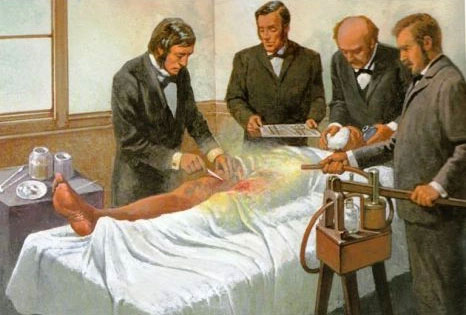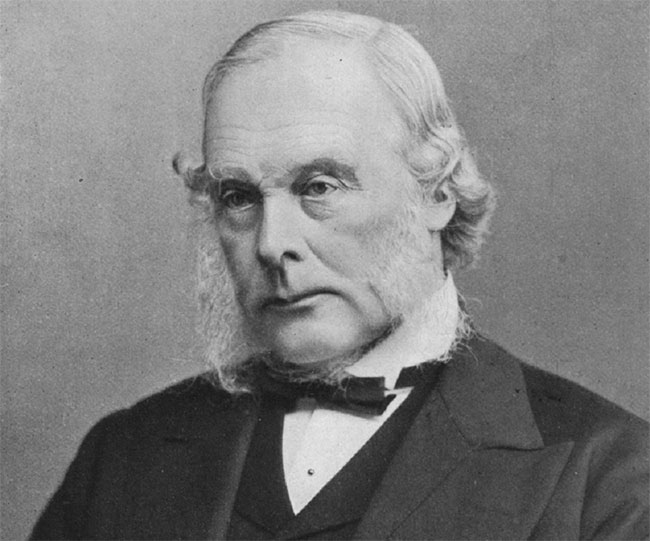To sterilize surgical instruments and clean wounds, British surgeon Joseph Lister invented carbolic acid disinfectant.

This invention made him a pioneer in preventive medicine and one of the most significant contributors to the history of world medicine.
By the early 19th century, the role of surgery in treating diseases and injuries had been established. Many patients had survived near-fatal conditions. However, the mortality rate during treatment did not decrease. Some patients who seemed to be saved by surgery gradually succumbed to complications from the procedure. The causes were unexplained, and no one knew how to prevent this situation.
Ultimately, the solution was found by Dr. Joseph Lister when he discovered the role of disinfectants in controlling infectious diseases. This marked a significant milestone in surgical history and was one of the earliest efforts to control and manage surgical infections.
Life and Career
Dr. Joseph Lister (1827-1912) was born into a wealthy family in Upton (Essex, a suburb of London), with a father who was a merchant, physicist, and optical researcher. Growing up in a family passionate about natural science, Lister developed a serious and rigorous approach to scientific research from a young age.

Joseph Lister – “the father of antiseptics.”
In his youth, he attended several of the best schools in the region. His father helped him learn how to use a microscope and study natural history. He performed dissections on small animals and observed them under the microscope. By 1852, Lister graduated with honors from University College London with a degree in medicine. Shortly after, he moved to work at a hospital in Edinburgh (Scotland) as a surgical doctor.
After graduation, he became a member of the Royal College of Surgeons and a house surgeon. In the autumn of 1853, Joseph Lister visited Edinburgh and fortuitously met the brilliant surgeon James Syme (who later became Lister’s father-in-law) and became his assistant. Joseph Lister actively participated in assisting Dr. James Syme’s surgeries at the Royal Edinburgh Infirmary and as an assistant at the University of Edinburgh.
On April 24, 1855, he was elected a fellow of the Royal College of Surgeons of Edinburgh. In October 1855, Lister was appointed as a lecturer at the Edinburgh School of Surgery, replacing Dr. Richard James Mackenzie.
In October 1856, Joseph Lister became a professor of surgery at the Royal Edinburgh Infirmary. In 1860, Lister was appointed as a professor of surgery at the University of Glasgow. In 1861, he took the position of surgeon at the Royal Infirmary of Glasgow.
Between 1861 and 1865, in the Male Accident Ward he oversaw, 45-50% of his amputee patients died from blood infections. He realized that for closed wounds, despite being severely bruised, treatment often led to quick healing. However, for open wounds, patients were often susceptible to severe infections, making recovery difficult and life-threatening. The high mortality rate from blood infections prompted Joseph Lister to begin experiments on antiseptics.
In a discussion about infections with chemistry professor Thomas Anderson in 1865, Lister was introduced to the book titled “Studies on the Phenomenon of Decay” by French chemist Louis Pasteur. Lister was astonished and focused on Pasteur’s argument that there were microbial germs in the air. This was the cause of fermentation and decay. Could it be that the operating room air was also filled with these pathogens? Lister pondered and sought ways to clean the surgical process.
Invention of Antiseptics
Joseph Lister discovered carbolic acid, commonly used for cleaning sewers. Acting on this, Dr. Lister decided to test the method of disinfecting with carbolic acid on cases of open wounds. He sterilized gauze with carbolic acid (now known as phenol).

Dr. Joseph Lister discovered the role of disinfectants in controlling infectious diseases.
In 1865, he succeeded in using carbolic acid to disinfect the wound of a boy named James Greenlees, dressing the wound with carbolic acid-soaked gauze and regularly changing the dressings. After four days, the boy’s wound showed no signs of infection, dried quickly, had no pus, and healed rapidly. From then on, Joseph Lister always required his colleagues to use 5% carbolic acid to disinfect their hands and surgical instruments. Subsequently, many doctors adopted disinfection practices, and the rate of patient deaths from blood infections decreased.
Believing that air also contained bacteria, in 1870, Lister decided to pump carbolic acid into and disperse it throughout the operating room air to sterilize it. However, this was a significant challenge because carbolic acid in vapor form could be toxic to medical staff and patients. Furthermore, surgeons washing their hands with carbolic acid could experience skin irritation and allergic dermatitis. Additionally, using carbolic acid to wash wounds could penetrate tissues, killing bacteria but also causing necrosis. Due to these drawbacks, Lister’s antiseptic technique was eventually replaced by a more refined method: aseptic technique.
However, Lister’s aseptic technique was met with resistance from colleagues. Yet in some countries, especially Germany, Lister’s methods were widely adopted. From 1875, Lister’s methods spread to other European countries. Gradually, this method was popularized and adopted in the United States. Ultimately, scientists in Lister’s homeland acknowledged his innovations.
In 1880, Lister received honorary degrees from the universities of Oxford and Cambridge. Three years later, he was made a baronet. By 1895, Lister was elected president of the Royal Society. Two years later, he became a member of the British Senate, marking the first time a physician received this honor.
After a long career in scientific research, Joseph Lister passed away on February 10, 1912, in Walmer (Kent) at the age of 85.
Other Antiseptics Developed
Today, carbolic acid is no longer widely used in controlling and managing surgical infections, but this historical discovery has made Joseph Lister one of the greatest medical figures in history. He is regarded as the father of antiseptics.
With modern medicine, many types of antiseptics have been developed that can kill all bacteria. Today, some commonly used antiseptics include: hydrogen peroxide, ethanol, iodine-based products, silver-based products, and chlorhexidine.


















































